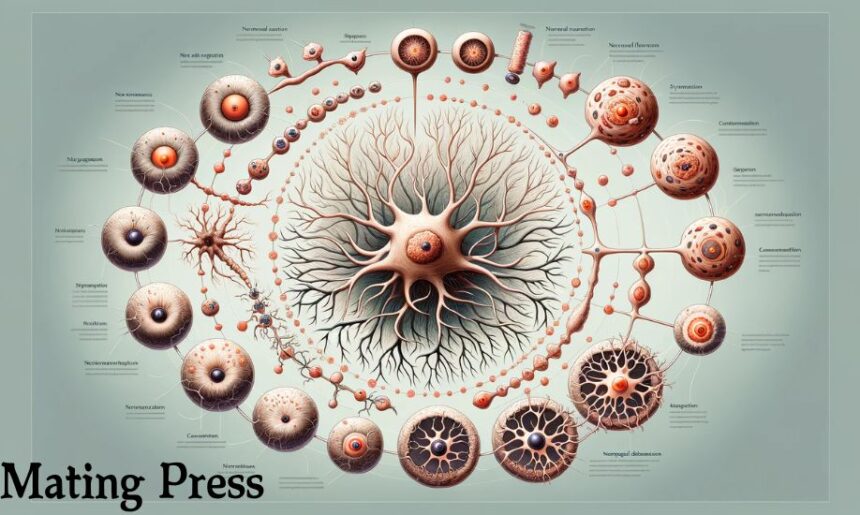The brain is an incredibly complex organ, filled with billions of neurons, all of which are essential for various cognitive and bodily functions. Neurons, or nerve cells, are the primary functional units of the brain, responsible for transmitting signals between different parts of the body. But how do neurons form, function, and eventually die? This journey is encapsulated in the life cycle of neurons, a fascinating process that involves several stages, each crucial to brain health and cognitive function.
In this article, we will delve into the details of the Life Cycle of Neurons Nabiha, exploring how neurons develop, mature, perform their functions, and eventually degenerate. Understanding this process is key to unlocking the mysteries of the brain and addressing various neurological disorders.
Mating Press will guide you through these stages to provide a comprehensive understanding of the Life Cycle of Neurons Nabiha.
Neurogenesis: The Birth of Neurons
The first stage of the Life Cycle of Neurons Nabiha is neurogenesis, which refers to the creation of new neurons. This process primarily occurs during the early stages of brain development, particularly in the embryo. However, recent research suggests that neurogenesis can also continue into adulthood in specific regions of the brain, such as the hippocampus, which is crucial for memory and learning.
In the early stages of development, neural stem cells in the brain divide and differentiate into neurons. These newly formed neurons then migrate to their designated locations within the brain, where they begin to establish connections with other neurons. The process of neurogenesis is vital for the proper formation of neural circuits, which are essential for brain function.
As part of the Life Cycle of Neurons Nabiha, neurogenesis plays a critical role in brain plasticity—the brain’s ability to adapt and change in response to new experiences. This adaptability is crucial for learning, memory, and recovery from brain injuries.
Neuronal Maturation: Growing into Functionality
Once neurons are formed, they enter the next phase of the Life Cycle of Neurons Nabiha, known as neuronal maturation. During this stage, neurons grow dendrites and axons, the branches that allow them to connect with other neurons and transmit signals. Dendrites receive signals from other neurons, while axons send signals to other neurons or muscles.
The process of establishing these connections is known as synaptogenesis, and it is a critical part of brain development. In this stage, neurons form synapses—small gaps between neurons where chemical signals are transmitted. These synapses allow neurons to communicate with each other, enabling complex neural networks to form.
During the maturation phase, neurons also undergo a process called myelination, where a fatty substance called myelin wraps around the axons. This myelin sheath acts as insulation, allowing electrical signals to travel more efficiently along the axon. Myelination is essential for the rapid transmission of signals between neurons, which is crucial for cognitive functions such as thinking, memory, and coordination.
Synaptic Plasticity: Adapting to New Information
One of the most fascinating aspects of the Life Cycle of Neurons Nabiha is the brain’s ability to adapt and change in response to new information. This adaptability is known as synaptic plasticity, and it is a key feature of neuronal function. Synaptic plasticity allows the brain to strengthen or weaken connections between neurons based on experience.
For example, when you learn a new skill or form a new memory, certain synapses in your brain are strengthened, making it easier for those neurons to communicate in the future. Conversely, synapses that are not used frequently may weaken over time. This process is essential for learning and memory, as it allows the brain to store and retrieve information efficiently.
Synaptic plasticity is a continuous process throughout the Life Cycle of Neurons Nabiha, and it is one of the reasons why the brain can recover from injuries and adapt to new situations. However, as we age, the brain’s ability to undergo synaptic plasticity may decline, which can lead to cognitive decline and memory problems.
Neuronal Degeneration: Aging and Disease
The final stage of the Life Cycle of Neurons Nabiha is neuronal degeneration, which occurs as neurons age and eventually die. Neuronal degeneration is a natural part of aging, but it can also be accelerated by various factors such as injury, toxins, and neurodegenerative diseases like Alzheimer’s and Parkinson’s.
As neurons age, they become less efficient at transmitting signals, and their ability to form new connections diminishes. This decline in function can lead to cognitive problems such as memory loss, difficulty concentrating, and impaired decision-making.
In some cases, neurons may undergo a process called apoptosis, or programmed cell death. This is a natural process that occurs when neurons are no longer needed or have been damaged beyond repair. However, in neurodegenerative diseases, this process can become dysregulated, leading to the premature death of neurons and the breakdown of neural circuits.
One of the key features of neurodegenerative diseases is the accumulation of abnormal proteins in the brain, which can interfere with neuronal function and lead to cell death. For example, in Alzheimer’s disease, the accumulation of amyloid plaques and tau tangles disrupts communication between neurons, leading to memory loss and cognitive decline.
The Role of Neurotransmitters in the Life Cycle of Neurons Nabiha
Throughout the Life Cycle of Neurons Nabiha, neurotransmitters play a crucial role in transmitting signals between neurons. Neurotransmitters are chemical messengers that are released by neurons to communicate with each other. Different neurotransmitters have different effects on the brain, and imbalances in these chemicals can lead to a variety of neurological disorders.
For example, dopamine is a neurotransmitter that is involved in reward, motivation, and movement. Imbalances in dopamine levels have been linked to conditions such as Parkinson’s disease and schizophrenia. Similarly, serotonin is a neurotransmitter that regulates mood, and imbalances in serotonin levels have been associated with depression and anxiety.
Understanding the role of neurotransmitters in the Life Cycle of Neurons Nabiha is essential for developing treatments for neurological disorders. By targeting specific neurotransmitter systems, scientists can develop drugs that can restore balance to the brain and improve cognitive function.
Neuroplasticity and Recovery: Hope for the Future
One of the most promising areas of research in the Life Cycle of Neurons Nabiha is neuroplasticity, the brain’s ability to reorganize itself in response to injury or disease. Neuroplasticity offers hope for individuals suffering from brain injuries or neurodegenerative diseases, as it suggests that the brain has the ability to heal itself and form new connections.
For example, after a stroke, the brain can sometimes rewire itself to compensate for the loss of function in damaged areas. Similarly, individuals with neurodegenerative diseases may be able to maintain cognitive function for longer periods by engaging in activities that promote neuroplasticity, such as learning new skills, exercising, and maintaining social connections.
While the Life Cycle of Neurons Nabiha may involve the eventual degeneration of neurons, the concept of neuroplasticity offers a hopeful outlook for the future. By harnessing the brain’s natural ability to adapt and change, researchers may be able to develop new therapies that can slow or even reverse the effects of neurodegenerative diseases.
Conclusion
The Life Cycle of Neurons Nabiha is a complex and fascinating process that involves the birth, maturation, function, and eventual degeneration of neurons. From the initial stages of neurogenesis to the final stages of neuronal death, each phase of the neuron’s life cycle is essential for brain health and function.
Understanding the Life Cycle of Neurons Nabiha not only sheds light on how the brain works but also offers valuable insights into neurological disorders and potential treatments. As research into neuroplasticity and neurogenesis continues to advance, the future holds promise for new therapies that can enhance brain function and improve quality of life for individuals with brain injuries and neurodegenerative diseases.
As Mating Press explores these scientific developments, it becomes clear that the brain’s ability to adapt and recover is one of its most remarkable features. By learning more about the Life Cycle of Neurons Nabiha, we can continue to unlock the mysteries of the brain and pave the way for new medical breakthroughs.






